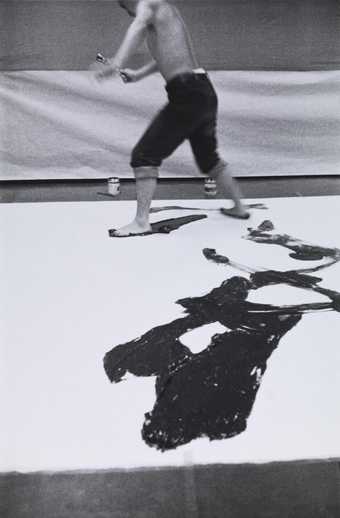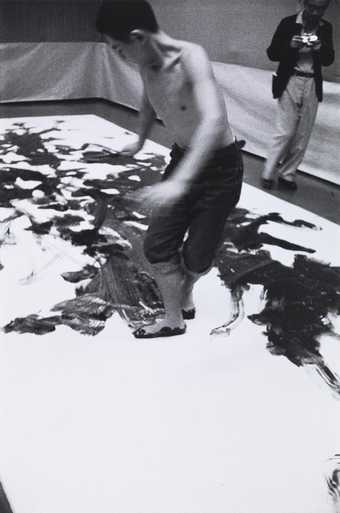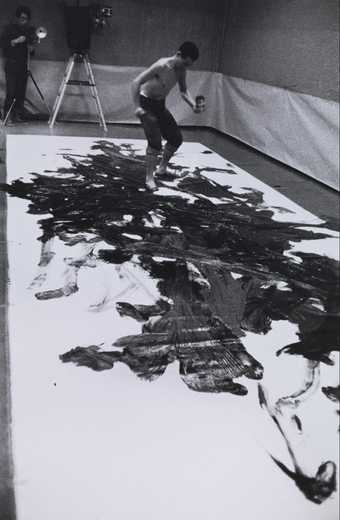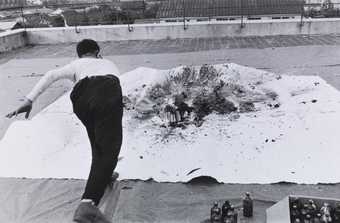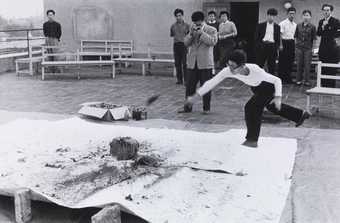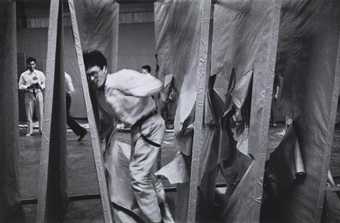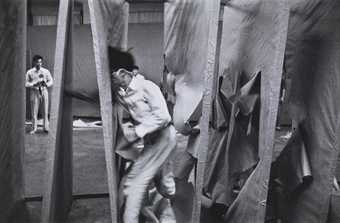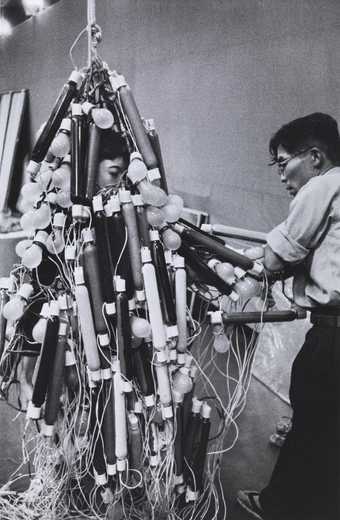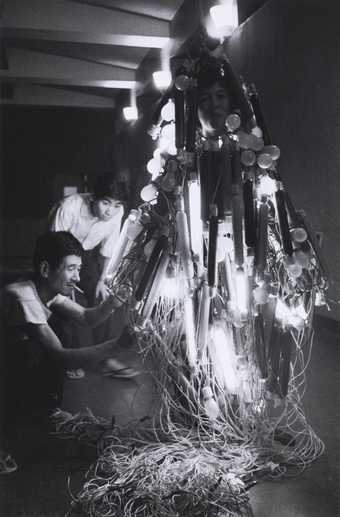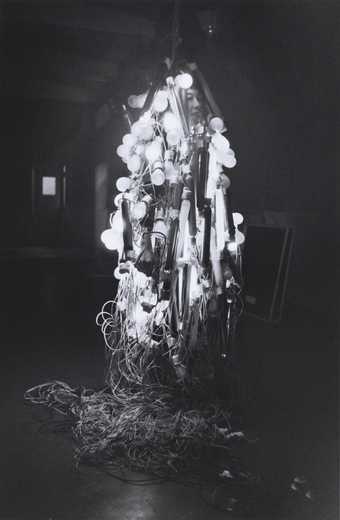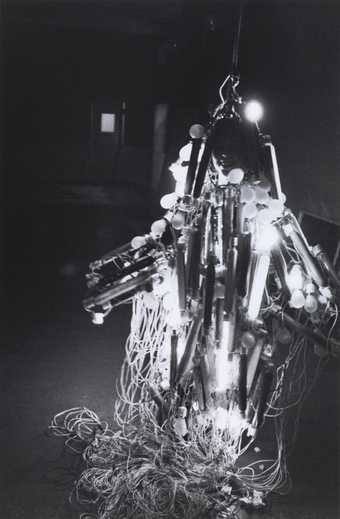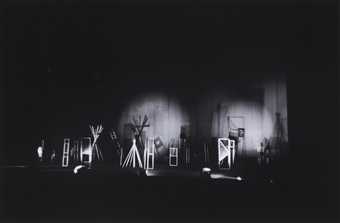
In Tate Modern
- Artist
- Kiyoji Otsuji 1923–2001
- Medium
- Photograph, gelatin silver print on paper
- Dimensions
- Image: 207 × 315 mm
- Collection
- Tate
- Acquisition
- Purchased with funds provided by the Asia-Pacific Acquisitions Committee 2019
- Reference
- P82296
Summary
This photograph is from the Japanese photographer Kiyoji Otsuji’s portfolio of forty-eight photographs known collectively as the Gutai Portfolio (Tate P82274–321). The portfolio comprises forty-eight black and white photographs, printed posthumously in 2012 with permission from the artist’s estate from negatives which were made between 1956 and 1957. This set is the seventh in an edition of seventeen; there also exist three artist’s proofs (other editions of the portfolio are in the collections of the Inhotim Institute in Brumadinho, Brazil and The Dallas Museum of Art). The series of images document emblematic works by members of the Japanese Gutai group, such as Tanaka Atsuko’s (born 1932) Electric Dress 1956 and Murakami Saburo’s (1925–1996) performance Passing Through 1956; such images are at times the only remaining manifestation of the often ephemeral work and actions of the Gutai artists and, as such, have been used to represent their work in publications and exhibitions about the group. The portfolio can be divided into twelve groups of images relating to performative actions that were conceived either as part of the production process for an artwork, or which constituted the work of art in itself. They relate to two landmark Gutai exhibitions: the 2nd Gutai Exhibition at Ohara Kaikan, Tokyo, circa 11–17 October 1956, and the Gutai Art on the Stage exhibition at the Sankei Kaikan halls in Osaka and Tokyo in 1957.
The Gutai Art Association (‘Gutai Bijutsu Kyokai’), active between 1954 and 1972, was founded by the artist Yoshihara Jiro (1905–1972). Against the backdrop of rapidly changing economic conditions of Japan’s post-war period, which conversely encouraged societal homogeneity and conformity, Gutai espoused the importance of individual freedom and creative expression. In its eponymous journal, as well as including work by Gutai members, it published images of paintings by both European ‘art informel’ artists (such as Georges Mathieu, 1921–2012) and American abstract expressionist artists such as Jackson Pollock (1912–1956). Jiro’s call to originality with his central tenet ‘do what no one has done before!’ resulted in Gutai works being stylistically disparate; yet they are unified by the artists’ application of quotidian materials and use of bodily actions to realise their work. Each of the artists forsook traditional methods of art-making in the confines of the studio, in favour of employing bodily expression for which the artwork then stood as a trace or a remnant of the primary event.
Gutai works were formally presented in a number of exhibitions organised by the group. In respect of this portfolio, the exhibition Gutai Art on the Stage was presented in 1957 at the Sankei Kaikan halls in Osaka and Tokyo consecutively. It exemplified an aspiration for art to pervade everyday life, including the theatre and music hall, and is notable for being the Gutai exhibition in which ‘performance reached a theoretical and artistic maturity’ (Ming Tiampo, ‘Please Draw Freely,’ in Tiampo and Munroe 2013, p.60). The full list of events and works recorded in the portfolio is as follows:
2nd Gutai Exhibition:
Shiraga Kazuo demonstrating his signature painting style, 1956 (nine photographs);
Shimamoto Shozo making a painting by hurling glass bottles of paint against a canvas 1956 (six photographs);
Murakami Saburo, Passing Through 1956 (six photographs);
Tanaka Atsuko, Electric Dress 1956 (five photographs).
Gutai Exhibition on the Stage:
Kanayama Akira, Giant Balloon 1957 (six photographs);
Sumi Yasuo, Painting in Space 1957 (one photograph);
Yoshida Toshio, Image 1957 (one photograph);
Shimamoto Shozo, Material Destruction 1957 (one photograph);
Murakami Saburo, Wrestling with Folding Screen 1957 (one photograph);
Shiraga Kazuo, Ultramodern Sanbaso 1957 (seven photographs);
Tanaka Atsuko, Stage Clothes 1957 (three photographs);
Motonaga Sadamasa, Smoke 1957 (two photographs).
Kiyoji Otsuji was an experimental photographer active in Japan in the post-war period. The photographs within this portfolio are amongst the few known photographs that depict the performative actions of the artist members of the Gutai Art Association, specifically across the years 1956 and 1957. He was also a member of the avant-garde collective Experimental Workshop (Jikken Kobo), active between 1951 and 1957. Also in Tate’s collection are a group of twenty black and white photographs that he made for APN (Asahi Picture News), in collaboration with the Gutai sculptor Yamaguchi Katsuhiro (1928–2018) and the photographer Shozo Kitadai (1921–2001; see Tate P80013–P80032).
Further reading
Ming Tiampo and Alexandra Munroe (eds.), Gutai: Splendid Playground, New York 2013.
Katy Wan
June 2018
Does this text contain inaccurate information or language that you feel we should improve or change? We would like to hear from you.
You might like
-
Kiyoji Otsuji Shiraga Kazuo demonstrating his signature painting style, 2nd Gutai Exhibition
1956, printed 2012 -
Kiyoji Otsuji Shiraga Kazuo demonstrating his signature painting style, 2nd Gutai Exhibition
1956, printed 2012 -
Kiyoji Otsuji Shiraga Kazuo demonstrating his signature painting style, 2nd Gutai Exhibition
1956, printed 2012 -
Kiyoji Otsuji Shiraga Kazuo demonstrating his signature painting style, 2nd Gutai Exhibition
1956, printed 2012 -
Kiyoji Otsuji Shiraga Kazuo demonstrating his signature painting style, 2nd Gutai Exhibition
1956, printed 2012 -
Kiyoji Otsuji Shimamoto Shozo making a painting by hurling glass bottles of paint against a canvas, 2nd Gutai Art Exhibition
1956, printed 2012 -
Kiyoji Otsuji Shimamoto Shozo making a painting by hurling glass bottles of paint against a canvas, 2nd Gutai Art Exhibition
1956, printed 2012 -
Kiyoji Otsuji Murakami Saburo, Passing Through, 2nd Gutai Art exhibition
1956, printed 2012 -
Kiyoji Otsuji Murakami Saburo, Passing Through, 2nd Gutai Art exhibition
1956, printed 2012 -
Kiyoji Otsuji Tanaka Atsuko, Electric Dress, 2nd Gutai Exhibition
1956, printed 2012 -
Kiyoji Otsuji Tanaka Atsuko, Electric Dress, 2nd Gutai Exhibition
1956, printed 2012 -
Kiyoji Otsuji Tanaka Atsuko, Electric Dress, 2nd Gutai Exhibition
1956, printed 2012 -
Kiyoji Otsuji Tanaka Atsuko, Electric Dress, 2nd Gutai Exhibition
1956, printed 2012 -
Kiyoji Otsuji Yoshida Toshio, Image, Gutai Exhibition on the Stage
1957, printed 2012 -
Kiyoji Otsuji Motonaga Sadamasa, Smoke, Gutai Exhibition on the Stage
1957, printed 2012

